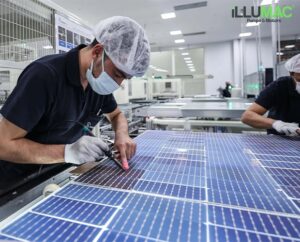What exactly is solar energy?

The end result? Our sun is approximately seven million degrees Fahrenheit in temperature and constantly emits massive amounts of energy in the form of electromagnetic radiation (EMR). EMR comes in many forms, and the sun generates all of them, which are carried to Earth in the form of photons.
The science behind solar panels: The photovoltaic effect and solar cells

Explanation of the photovoltaic effect
The photovoltaic effect is at the heart of the science of generating electricity with solar panels. The photovoltaic effect, discovered by Edmond Becquerel in 1839, is a property of certain materials (known as semiconductors) that allows them to generate an electric current when exposed to sunlight.
The photovoltaic effect operates in the following steps:
Sunlight strikes the solar cells, energizing electrons and setting them in motion.
An electrical current is created when electrons flow out of the junction between cell layers.
Metal plates and wires capture electron flow and generate electricity.
The process of generating solar electricity begins with solar cells, which are the individual components of a larger solar panel. Solar cells are typically made of silicon (atomic number 14 on the periodic table). Silicon is a nonmetal semiconductor that can absorb and convert sunlight into electricity; silicon is also used in nearly every computer on the planet. There are several types of semiconductors commonly used in solar cells, with silicon being by far the most common, accounting for 95% of all solar cells manufactured today. The two main semiconductor materials used in thin-film solar panel production are cadmium-telluride and copper indium gallium diselenide.
In photovoltaic cells, two layers of silicon are used, and each one is specially treated, or “doped,” to create an electric field at the junction between the layers. This electric field causes free electrons to flow through the solar cell and out of the silicon junction, resulting in the generation of an electrical current. To create the positive and negative sides of a photovoltaic cell, phosphorus and boron are commonly used as positive and negative doping agents, respectively.
The electrons pushed out by the electric field are collected by metal plates on the sides of each solar cell and transferred to connecting wires. Electrons flow as electricity through the wiring to a solar inverter and then throughout your home at this point.

Solar cell alternatives to silicon
While silicon is the most common semiconductor used in solar panels around the world, there are other options used in some new and emerging solar products.
Thin-film solar cells are a type of solar cell that is made of lightweight and/or flexible materials. Thin-film solar cells are classified into four chemical types: Cadmium Telluride (CdTe), Amorphous Silicon (a-Si), and Copper Indium Gallium Selenide (CIGS), and Gallium Arsenide (GaAs). The light-absorbing layers in these cells are 350 times smaller than those in silicon cells, thus the term “thin-film.”
Organic solar cells are a subset of thin-film solar cells that rely on carbon-based materials as a semiconductor. These organic photovoltaics (OPV) are made by dissolving organic compounds in ink and printing them onto thin plastics. They are also known as “plastic solar cells” or “polymer solar cells.”
Perovskite solar cells are a type of thin-film solar cell that is made of perovskites, which are man-made materials with a unique crystallographic structure that allows them to convert photons of light into usable electricity. Perovskite cells are created using “solution processing,” the same method used to print newspapers.
Other important solar panel components
The glass casing of the panels provides durability and protection for the silicon PV cells. Solar panels have an insulation layer and a back sheet beneath the glass exterior to protect against heat dissipation and humidity inside the panel. This insulation is critical because temperature increases reduce efficiency, resulting in lower solar panel performance. Solar panels have an anti-reflective coating that increases sunlight absorption and exposes the cells to the maximum amount of sunlight.
When it comes to silicon solar cells, there are two cell formations that are commonly used: monocrystalline and polycrystalline. Monocrystalline cells are composed of a single silicon crystal, whereas polycrystalline cells are composed of silicon fragments. Monocrystalline formats allow for more electron movement and thus provide a higher efficiency solar technology than polycrystalline formats, though they are typically more expensive.
How do solar panels generate electricity for your home? Explanation in detail

1. Photovoltaic cells absorb solar energy and convert it to direct current electricity.
2. Solar inverters convert direct current (DC) electricity from your solar modules to alternating current (AC), which is used by most home appliances.
3. Electricity circulates throughout your home, powering electronic devices.
4. Excess electricity generated by solar panels is fed into the power grid.
What about alternatives to photovoltaics?
Solar water heating
There is no electron movement in a solar hot water system. Rather, the panels convert sunlight into heat. A solar thermal system’s panels, known as “collectors,” are typically installed on a rooftop. They collect energy in a very different way than traditional photovoltaic panels, generating heat rather than electricity. Sunlight passes through the glass covering of a collector and strikes an absorber plate, which has a coating designed to capture solar energy and convert it to heat. This heat is transferred to a “transfer fluid” (antifreeze or potable water) contained in small pipes within the plate.
Solar concentrating power
CSP is most commonly used in utility-scale installations to help power a power grid.
Solar panels ensure significant cost savings.
If you want to start saving money on electricity and investing in renewable energy, compare solar panel system quotes first. That’s where Illumac comes in: when you create a free account on the Illumac Marketplace, we’ll send you customized quotes from installers in your area. So, what are you waiting for? Begin your clean energy journey with Illumac today!






